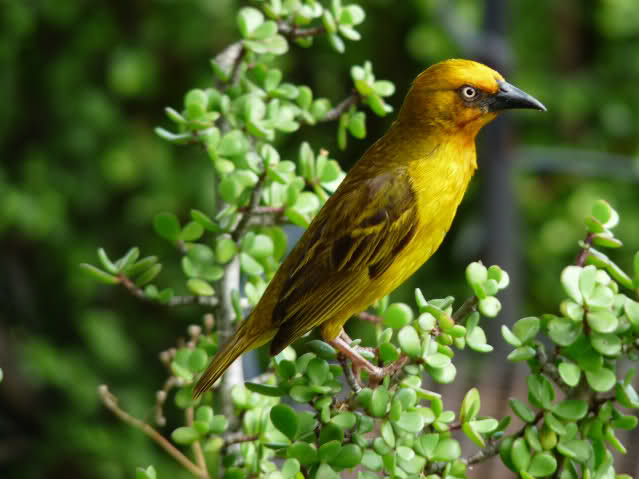Crested Barbet wrote:
Cape Weaver (male)
WEAVERS - BIRD OF THE MONTH - JUNE & JULY 2014*
- Flutterby
- Posts: 44029
- Joined: Sat May 19, 2012 12:28 pm
- Country: South Africa
- Location: Gauteng, South Africa
- Contact:
Re: Bird Photos - Not Park Specific
Some more pics from Footloose Trout Farm. This Red Bishop kept me entertained for ages. -O It was obviously putting on a show for its mate, and would puff itself up, then deflate, then stretch and puff up again! 

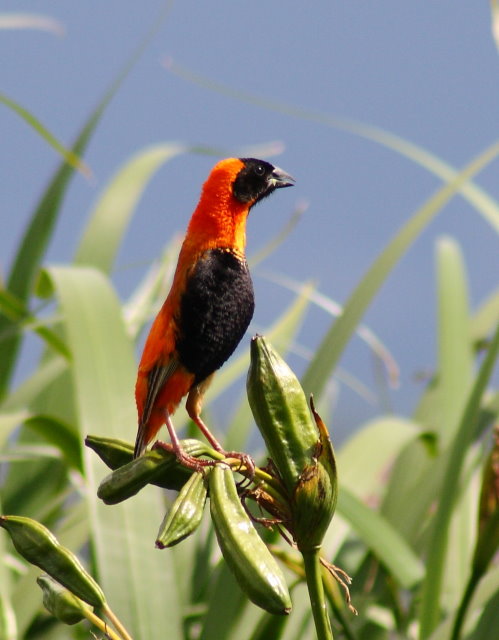
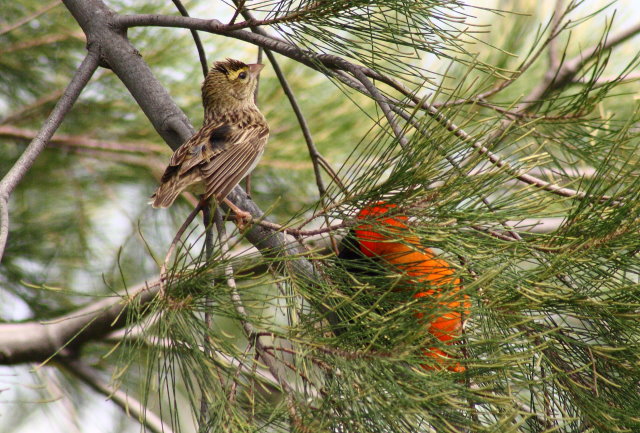
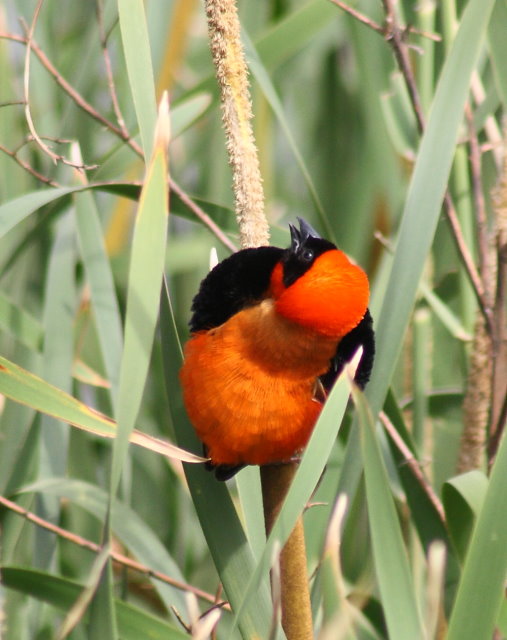




- Lisbeth
- Site Admin
- Posts: 65591
- Joined: Sat May 19, 2012 12:31 pm
- Country: Switzerland
- Location: Lugano
- Contact:
11 Interesting Facts about Sociable Weavers
by Christian Boix on July 9, 2013 in Birds
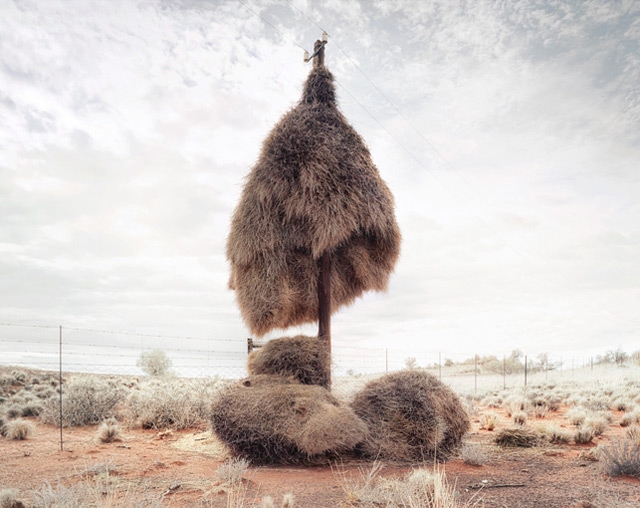
1. There are four subspecies:
- Philetairus socius eremnus, living in the Orange River Valley;
- Philetairus socius socius, inhabiting the S. Kalahari in NW Northern Cape and S. Namibia;
- Philetairus socius xericus, roughing it in the Namibian escarpments;
- Philetairus socius geminus, isolated from all other sub-species and thriving in Etosha and S. Owambo areas in N. Namibia.
2. Unlike other weavers who build their nests in the breeding season, Sociable Weavers use and maintain the nests throughout the year. They nest in colonies as small as 10 individuals and up to 400-500 birds. Their nests are instantly recognizable, massive and resembling huge apartment blocks. The nest structures can reach heights of up to 4 m. From a distance the nest may typically look like a haystack stuck up on a large tree or telephone pole.
3. Preferred nesting sites are generally long, smooth, poles or sparsely-branched trees to deter predators such as Cape Cobras, Black Mambas, Boomslangs, baboons, rats or genets are always after weaver chicks and so preferred nesting sites are generally long, smooth, poles or sparsely-branched trees.
4. Different materials are utilized for different sections of the nest, each material choice being purposefully selected. Large twigs and stems, placed at an angle and pointing downwards, cover the roof of the nest. Grasses are shoved into the structure until firmly secured. It is believed that the crown of sharp grass spikes picket-fencing the tunnel entrances may be designed as protection from predators.
5. Telephonic and Electrical Power companies have battled for years with the design of telephonic poles and power line structures able to cope with the weight of these nests, especially during the rainy season when they become somewhat waterlogged and become so heavy (several tons) that they drag down the supporting poles.
6. Photographic evidence has proven that some of these nest structures are over 100 years old.
7. Access to the nest core is via a smattering of galleries that lead to the breeding chambers, the tunnels leading to such chambers average 25 cm long and 7 cm wide, and the breeding chambers themselves are often 10 to 15 cm in diameter. The nesting chambers are lined with soft materials, such as feathers, fluff, wool, or hair.
8. Protection in numbers seems the favoured strategy, hence why colonies often resemble multispecies “ghettos”- often allowing other “guests” to breed and roost in the nest – including African Pigmy Falcons, Pied Barbets, Rosy-faced Lovebirds, Familiar Chats, finches, sparrows, tits, and opportunistic White-backed and Lappet-faced Vultures, Verreaux’s and Spotted Eagle Owl, as well as several Eagle species roosting and nesting on the top of the nest.
9. The nest has proven itself to be an effective temperature buffer, against the cold temperatures at night (especially in winter), and high temperatures during the day, reducing temperature variability in nest chambers. The extent of this buffering effect depends significantly on the position of nest chambers within the communal structure, and on the depth to which chambers are embedded within the nest mass. Not, surprisingly older and more veteran pairs tend to occupy chambers with the highest thermoregulatory benefits.
10. In winter this temperature insulation translates into significant energetic savings for its inhabitants, reducing their food intake demand and enhancing their ability to survive in the leanest months of southern Africa’s harshest semi-arid environments. In the heat of the day, or the chill of winter nights individuals ride the thermal challenge by roosting alone when hot, or together when cold.
11. Energetically rested and physiologically unstressed, Sociable Weavers live a poised existence ready to react to any unpredictable rainfall event. A mere 20mm downpour, even if out of season, may trigger the entire colony into breeding mode, and depending on how the environment reacts to the rain, breeding pairs may be able to churn out up to four broods (4-5 chicks each), with the offspring of the first brood helping their parents raise subsequent broods, and even attracting totally unrelated “helpers” eager to ensure that enough food is found for the last broods as resources wane and dwindle away.
See below for photographs of the Sociable weaver’s nest, taken in the Kalahari Desert, South Africa.
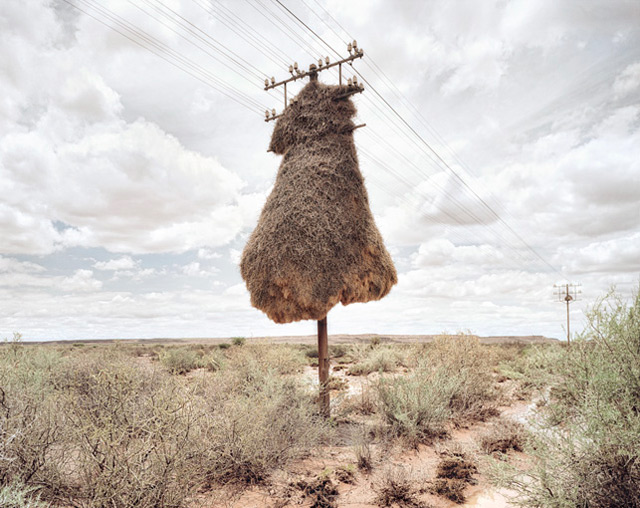
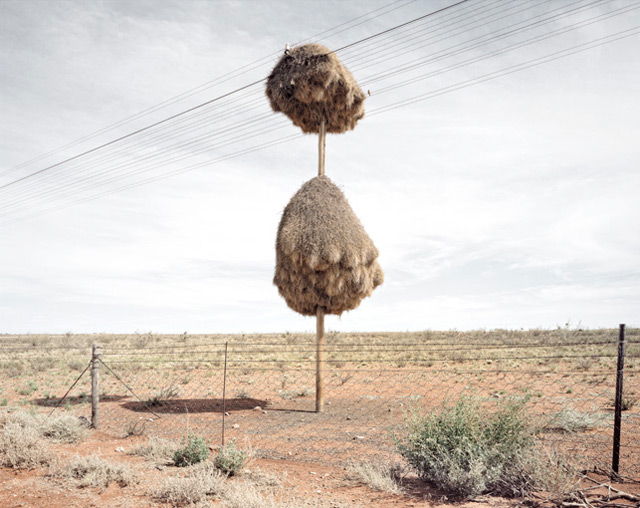
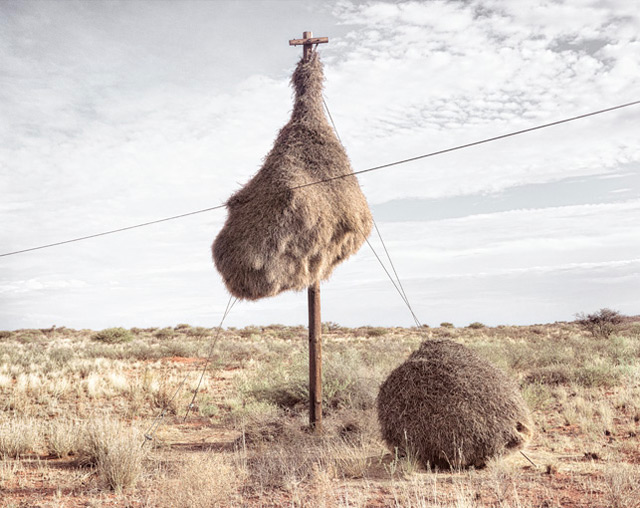
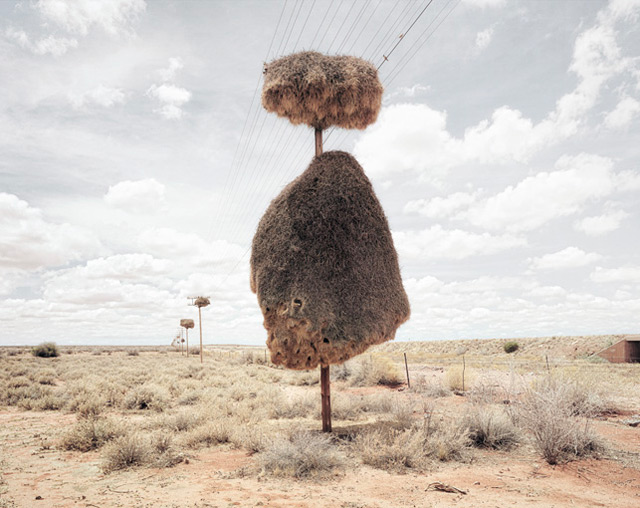
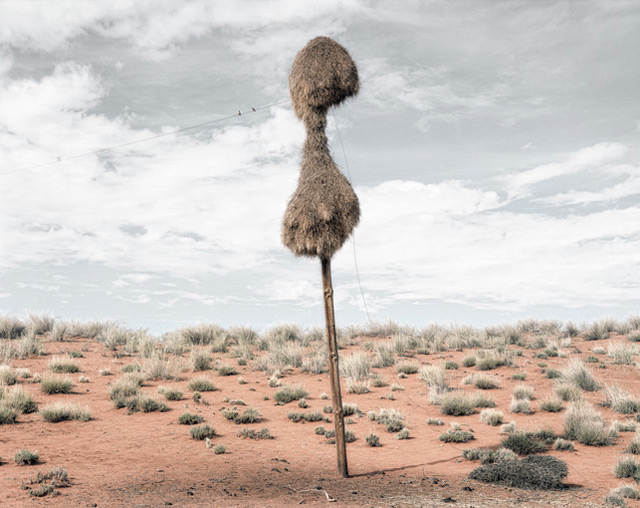
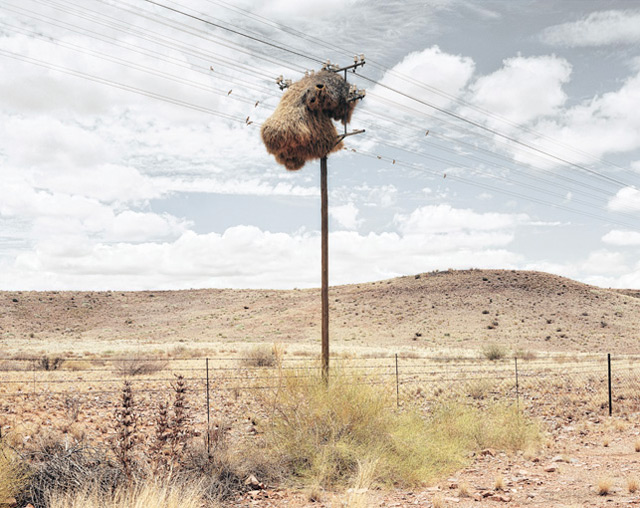

1. There are four subspecies:
- Philetairus socius eremnus, living in the Orange River Valley;
- Philetairus socius socius, inhabiting the S. Kalahari in NW Northern Cape and S. Namibia;
- Philetairus socius xericus, roughing it in the Namibian escarpments;
- Philetairus socius geminus, isolated from all other sub-species and thriving in Etosha and S. Owambo areas in N. Namibia.
2. Unlike other weavers who build their nests in the breeding season, Sociable Weavers use and maintain the nests throughout the year. They nest in colonies as small as 10 individuals and up to 400-500 birds. Their nests are instantly recognizable, massive and resembling huge apartment blocks. The nest structures can reach heights of up to 4 m. From a distance the nest may typically look like a haystack stuck up on a large tree or telephone pole.
3. Preferred nesting sites are generally long, smooth, poles or sparsely-branched trees to deter predators such as Cape Cobras, Black Mambas, Boomslangs, baboons, rats or genets are always after weaver chicks and so preferred nesting sites are generally long, smooth, poles or sparsely-branched trees.
4. Different materials are utilized for different sections of the nest, each material choice being purposefully selected. Large twigs and stems, placed at an angle and pointing downwards, cover the roof of the nest. Grasses are shoved into the structure until firmly secured. It is believed that the crown of sharp grass spikes picket-fencing the tunnel entrances may be designed as protection from predators.
5. Telephonic and Electrical Power companies have battled for years with the design of telephonic poles and power line structures able to cope with the weight of these nests, especially during the rainy season when they become somewhat waterlogged and become so heavy (several tons) that they drag down the supporting poles.
6. Photographic evidence has proven that some of these nest structures are over 100 years old.
7. Access to the nest core is via a smattering of galleries that lead to the breeding chambers, the tunnels leading to such chambers average 25 cm long and 7 cm wide, and the breeding chambers themselves are often 10 to 15 cm in diameter. The nesting chambers are lined with soft materials, such as feathers, fluff, wool, or hair.
8. Protection in numbers seems the favoured strategy, hence why colonies often resemble multispecies “ghettos”- often allowing other “guests” to breed and roost in the nest – including African Pigmy Falcons, Pied Barbets, Rosy-faced Lovebirds, Familiar Chats, finches, sparrows, tits, and opportunistic White-backed and Lappet-faced Vultures, Verreaux’s and Spotted Eagle Owl, as well as several Eagle species roosting and nesting on the top of the nest.
9. The nest has proven itself to be an effective temperature buffer, against the cold temperatures at night (especially in winter), and high temperatures during the day, reducing temperature variability in nest chambers. The extent of this buffering effect depends significantly on the position of nest chambers within the communal structure, and on the depth to which chambers are embedded within the nest mass. Not, surprisingly older and more veteran pairs tend to occupy chambers with the highest thermoregulatory benefits.
10. In winter this temperature insulation translates into significant energetic savings for its inhabitants, reducing their food intake demand and enhancing their ability to survive in the leanest months of southern Africa’s harshest semi-arid environments. In the heat of the day, or the chill of winter nights individuals ride the thermal challenge by roosting alone when hot, or together when cold.
11. Energetically rested and physiologically unstressed, Sociable Weavers live a poised existence ready to react to any unpredictable rainfall event. A mere 20mm downpour, even if out of season, may trigger the entire colony into breeding mode, and depending on how the environment reacts to the rain, breeding pairs may be able to churn out up to four broods (4-5 chicks each), with the offspring of the first brood helping their parents raise subsequent broods, and even attracting totally unrelated “helpers” eager to ensure that enough food is found for the last broods as resources wane and dwindle away.
See below for photographs of the Sociable weaver’s nest, taken in the Kalahari Desert, South Africa.






"Education is the most powerful weapon which you can use to change the world." Nelson Mandela
The desire for equality must never exceed the demands of knowledge
The desire for equality must never exceed the demands of knowledge
- Mel
- Global Moderator
- Posts: 26737
- Joined: Sat May 19, 2012 12:31 pm
- Country: Germany
- Location: Föhr
- Contact:
Re: 11 Interesting Facts about Sociable Weavers
Amazing that they always find the right door to their apartment in housing blocks that massive. 
Interesting stuff - thanks, Lis.
Interesting stuff - thanks, Lis.
God put me on earth to accomplish a certain amount of things. Right now I'm so far behind that I'll never die.
Re: 11 Interesting Facts about Sociable Weavers
Very informative! Thanks for passing it along, I learned a thing or two...or three 

- nan
- Posts: 26454
- Joined: Thu May 31, 2012 9:41 pm
- Country: Switzerland
- Location: Central Europe
- Contact:
Re: 11 Interesting Facts about Sociable Weavers
very interesting Liz, thank you 
here is a Pygmy Falcon's nest in the nest of Sociable Weavers
9.3.2013 - Kgalagadi, North Auob river

here is a Pygmy Falcon's nest in the nest of Sociable Weavers
9.3.2013 - Kgalagadi, North Auob river

Kgalagadi lover… for ever
https://safrounet.piwigo.com/
https://safrounet.piwigo.com/
- Lisbeth
- Site Admin
- Posts: 65591
- Joined: Sat May 19, 2012 12:31 pm
- Country: Switzerland
- Location: Lugano
- Contact:
WEAVERS - BIRD OF THE MONTH - JUNE & JULY 2014*
As the family of the weavers is very big, it would be nice if we could do one species at a time, as far as possible. All the members are kindly requested to write the name of the bird next to the photo.
The Ploceidae, or weavers, are small passerine birds related to the finches.( Only the birds present in southern Africa are listed)
These are seed-eating birds with rounded conical bills, most of which are from Sub-Saharan Africa, with fewer species in tropical Asia. A few species have been introduced outside their native range. The weaver group is divided into the buffalo, sparrow, typical, and widow weavers. The males of many species are brightly coloured, usually in red or yellow and black, some species show variation in colour only in the breeding season.
Weaver birds, also known as weaver finches, get their name because of their elaborately woven nests (the most elaborate of any birds'), though some are notable for their selective parasitic nesting habits. The nests vary in size, shape, material used, and construction techniques from species to species. Materials used for building nests include fine leaf-fibers, grass, and twigs. Many species weave very fine nests using thin strands of leaf fiber, though some, like the buffalo-weavers, form massive untidy stick nests in their colonies, which may have spherical woven nests within. The sparrow weavers of Africa build apartment-house nests, in which 100 to 300 pairs have separate flask-shaped chambers entered by tubes at the bottom. Most species weave nests that have narrow entrances, facing downward.
Many weaver species are gregarious and breed colonially. The birds build their nests together for protection, often several to a branch. Usually the male birds weave the nests and use them as a form of display to lure prospective females. The weaver bird colonies may be found close to water bodies. They sometimes cause crop damage, notably the Red-billed Quelea, reputed to be the world's most numerous bird.
Species list
Genus Bubalornis
- Red-billed Buffalo Weaver, Bubalornis niger is a species of bird in the Ploceidae family. It is found in Angola, Botswana, Ethiopia, Kenya, Mozambique, Namibia, Rwanda, Somalia, South Africa, Sudan, Swaziland, Tanzania, Uganda, Zambia, and Zimbabwe. Its natural habitat is the dry savanna.
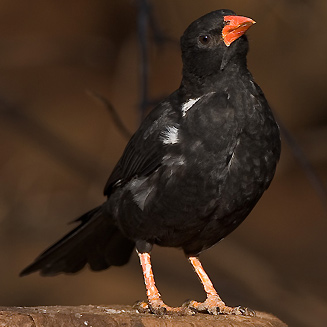 Red-billed buffalo-weaver, Krugersdorp, South Africa. [photo Gerhard Theron ©]
Red-billed buffalo-weaver, Krugersdorp, South Africa. [photo Gerhard Theron ©]
Distribution
Occurs in two separate areas of sub-Saharan Africa; one extending from Somalia and Ethiopia through to Tanzania and the other population from southern DRC, Angola and Zambia to southern Africa. Here it is locally common from northern and central Namibia to Botswana, Zimbabwe, southern Mozambique and northern and north-eastern South Africa.
Habitat:They are found in savanna, thornveld and dry woodland, mostly in Acacia savanna, especially when it has been disturbed by humans and livestock.
Diet
It feeds mainly on insects, particularly grasshoppers and caterpillars, but also takes seeds and fruit. It forages on the ground, searching the soil and low vegetation for food.
Breeding
This species is usually polygynous, with one male and several females occupying a nest. It is breeds in colonies made up of different separate "lodges", each with a number of nesting chambers within them. The males may be polygamous, each controlling 1-8 nest chambers and up to about 3 females; usually there is one dominant male in a colony who has the most females and egg chambers, while other males may have one female and a few chambers. The males vigorously defend their lodges against other males, using aggressive displays and calls, and females within harem do not tolerate each others presence in their egg chambers. Colonies may use a different system altogether, with two males cooperating with each other to build the nest, both defending the territory and helping to feed the chicks. The nest is a huge, bulky mass of interconnected thorny twigs, divided into separate complexes (lodges) with multiple egg chambers, each with a nest built by the female, consisting of a ball of grass, leaves and roots. The colony is typically placed in the branches of a large, often thorny tree or alternatively a windmill or pylon, usually near human habitation. In fact if the people in the area leave, the colony often departs as well. Large raptors such as White-backed vultures (Gyps africanus) and Bateleurs (Terathopius ecaudatus) often build their nests on top of Red-billed Buffalo-weaver nests; this is though to be mutually beneficial, as the raptor nests are camouflaged and the weavers are protected from other predators.
The Ploceidae, or weavers, are small passerine birds related to the finches.( Only the birds present in southern Africa are listed)
These are seed-eating birds with rounded conical bills, most of which are from Sub-Saharan Africa, with fewer species in tropical Asia. A few species have been introduced outside their native range. The weaver group is divided into the buffalo, sparrow, typical, and widow weavers. The males of many species are brightly coloured, usually in red or yellow and black, some species show variation in colour only in the breeding season.
Weaver birds, also known as weaver finches, get their name because of their elaborately woven nests (the most elaborate of any birds'), though some are notable for their selective parasitic nesting habits. The nests vary in size, shape, material used, and construction techniques from species to species. Materials used for building nests include fine leaf-fibers, grass, and twigs. Many species weave very fine nests using thin strands of leaf fiber, though some, like the buffalo-weavers, form massive untidy stick nests in their colonies, which may have spherical woven nests within. The sparrow weavers of Africa build apartment-house nests, in which 100 to 300 pairs have separate flask-shaped chambers entered by tubes at the bottom. Most species weave nests that have narrow entrances, facing downward.
Many weaver species are gregarious and breed colonially. The birds build their nests together for protection, often several to a branch. Usually the male birds weave the nests and use them as a form of display to lure prospective females. The weaver bird colonies may be found close to water bodies. They sometimes cause crop damage, notably the Red-billed Quelea, reputed to be the world's most numerous bird.
Species list
Genus Bubalornis
- Red-billed Buffalo Weaver, Bubalornis niger is a species of bird in the Ploceidae family. It is found in Angola, Botswana, Ethiopia, Kenya, Mozambique, Namibia, Rwanda, Somalia, South Africa, Sudan, Swaziland, Tanzania, Uganda, Zambia, and Zimbabwe. Its natural habitat is the dry savanna.
 Red-billed buffalo-weaver, Krugersdorp, South Africa. [photo Gerhard Theron ©]
Red-billed buffalo-weaver, Krugersdorp, South Africa. [photo Gerhard Theron ©]Distribution
Occurs in two separate areas of sub-Saharan Africa; one extending from Somalia and Ethiopia through to Tanzania and the other population from southern DRC, Angola and Zambia to southern Africa. Here it is locally common from northern and central Namibia to Botswana, Zimbabwe, southern Mozambique and northern and north-eastern South Africa.
Habitat:They are found in savanna, thornveld and dry woodland, mostly in Acacia savanna, especially when it has been disturbed by humans and livestock.
Diet
It feeds mainly on insects, particularly grasshoppers and caterpillars, but also takes seeds and fruit. It forages on the ground, searching the soil and low vegetation for food.
Breeding
This species is usually polygynous, with one male and several females occupying a nest. It is breeds in colonies made up of different separate "lodges", each with a number of nesting chambers within them. The males may be polygamous, each controlling 1-8 nest chambers and up to about 3 females; usually there is one dominant male in a colony who has the most females and egg chambers, while other males may have one female and a few chambers. The males vigorously defend their lodges against other males, using aggressive displays and calls, and females within harem do not tolerate each others presence in their egg chambers. Colonies may use a different system altogether, with two males cooperating with each other to build the nest, both defending the territory and helping to feed the chicks. The nest is a huge, bulky mass of interconnected thorny twigs, divided into separate complexes (lodges) with multiple egg chambers, each with a nest built by the female, consisting of a ball of grass, leaves and roots. The colony is typically placed in the branches of a large, often thorny tree or alternatively a windmill or pylon, usually near human habitation. In fact if the people in the area leave, the colony often departs as well. Large raptors such as White-backed vultures (Gyps africanus) and Bateleurs (Terathopius ecaudatus) often build their nests on top of Red-billed Buffalo-weaver nests; this is though to be mutually beneficial, as the raptor nests are camouflaged and the weavers are protected from other predators.
"Education is the most powerful weapon which you can use to change the world." Nelson Mandela
The desire for equality must never exceed the demands of knowledge
The desire for equality must never exceed the demands of knowledge
Re: WEAVERS - BIRD OF THE MONTH - JUNE 2014
Where to find Red-billed Buffalo-weaver in South Africa?
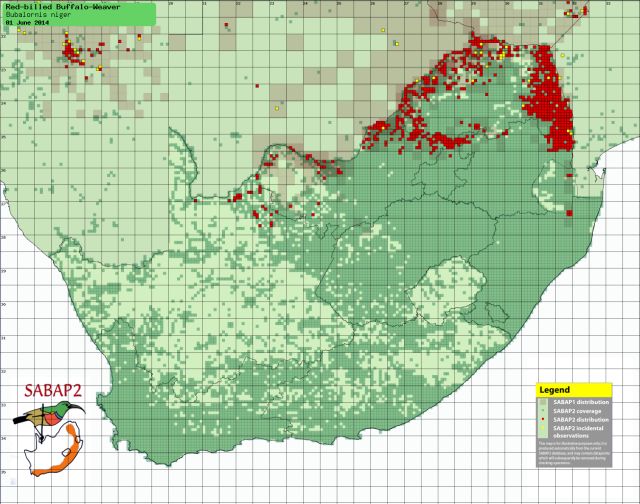
You can look up the Species occurance by site/nature reserve here

You can look up the Species occurance by site/nature reserve here
- nan
- Posts: 26454
- Joined: Thu May 31, 2012 9:41 pm
- Country: Switzerland
- Location: Central Europe
- Contact:
Re: WEAVERS - BIRD OF THE MONTH - JUNE 2014
Kruger - Red-billed Buffalo-Weaver / Alecto à bec rouge
 14.11.2009
14.11.2009
 in the nest 22.5.2011
in the nest 22.5.2011
 14.11.2009
14.11.2009 in the nest 22.5.2011
in the nest 22.5.2011Kgalagadi lover… for ever
https://safrounet.piwigo.com/
https://safrounet.piwigo.com/



